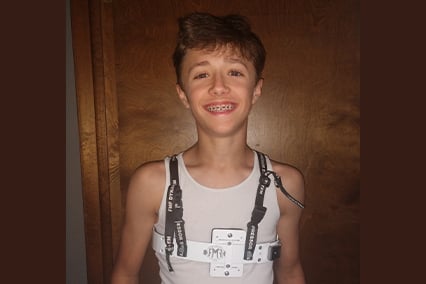Center for Pectus Excavatum and Carinatum
Center for Pectus Excavatum and Carinatum
The Center for Pectus Excavatum and Pectus Carinatum at Children’s Mercy is one of the largest centers for chest wall surgery and bracing in the country. The Pectus Center is the region’s only authorized bracing system provider, correcting nearly every pectus carinatum case without surgery. The recommended referral age to the pectus center is during early adolescence between 11-13 years old.
My chest goes in: pectus excavatum
Pectus excavatum (also known as sunken chest or funnel chest) is the most common difference of the chest in children. The surgical experts at Children’s Mercy are recognized leaders in repairing pectus excavatum by using the minimally invasive repair of pectus excavatum (MIRPE) or the Nuss procedure. Our surgery success rate is 99 percent.
Read about how Children’s Mercy treats pectus excavatum.
My chest goes out: pectus carinatum
Pectus carinatum is a common pediatric condition characterized by an unusual overgrowth of the rib cartilages. The Pectus Center offers a nonsurgical treatment option for kids with pectus carinatum called the dynamic compression system (DCS) brace. Children's Mercy is a national leader in treating pectus carinatum with the DCS brace. Because of this, most children with pectus carinatum in our care do not need surgery.
Resources for families
Our pectus team has put together resources that may be helpful for your family, including exercises, recommendations, travel letters, brace billing information and more.
Pectus carinatum
Pectus excavatum
Stories
Pectus carinatum: Rogan's story
An innovative bracing system – combined with a committed patient and family and a dedicated treatment team – helped achieve full correction of one teen’s pectus carinatum in just one month. Read Rogan’s story to learn more.

Inside Pediatrics: Jacob's story
Revolutionary cryoablation procedures pioneered at Children’s Mercy allow Jacob to recover with almost no discomfort from a chest repair that used to cause months of pain.
Highest level of surgical care
Children’s Mercy is one of only 53 centers in the nation to be verified as a Level 1 Children’s Surgery Center — the highest possible rating — by the American College of Surgeons. This verification means Children's Mercy meets the highest standards for safety and outcomes determined by the American College of Surgeons. Our surgical care is designed to manage routine to highly complex illnesses. We also have experts in every pediatric specialty ready to go at all times to provide comprehensive care for kids.

